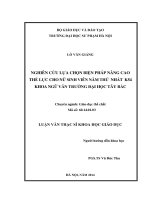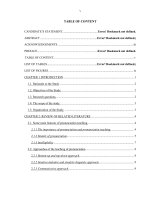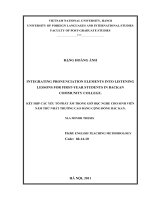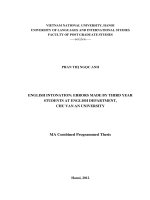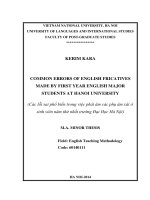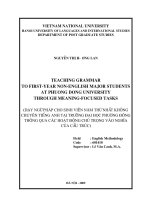First-year students' perspectives on the different types of teacher written feedback = Nhận thức của sinh viên năm thứ nhất về các hình thức phản hồi dưới dạng
Bạn đang xem bản rút gọn của tài liệu. Xem và tải ngay bản đầy đủ của tài liệu tại đây (788.26 KB, 109 trang )
VIETNAM NATIONAL UNIVERSITY, HANOI
UNIVERSITY OF LANGUAGES AND INTERNATIONAL STUDIES
FACULTY OF POST-GRADUATE STUDIES
PHẠM HOÀNG LONG BIÊN
NHẬN THỨC CỦA SINH VIÊN NĂM THỨ NHẤT
VỀ CÁC HÌNH THỨC PHẢN HỒI DƯỚI DẠNG VIẾT CỦA GIÁO VIÊN
FIRST-YEAR STUDENTS’ PERSPECTIVES
ON THE DIFFERENT TYPES OF TEACHER WRITTEN FEEDBACK
M.A. Combined Programme Thesis
Field: English Language Teaching Methodology (ELT)
Code: 60 14 10
SUBMITTED IN PARTIAL FULFILLMENT OF REQUIREMENTS
OF THE DEGREE OF MASTERS IN ENGLISH LANGUAGE TEACHING
Hanoi, May 2010
TABLE OF CONTENTS
Page
ABSTRACT
i
ACKNOWLEDGEMENTS
ii
LIST OF TABLES
iii
LIST OF FIGURES
iv
INTRODUCTION 1
1. Rationale for the study 1
2. Aims of the study 3
3. Research questions 4
4. Scope of the study 4
5. Definitions of terms 5
6. The significance of the study 6
CHAPTER ONE: LITERATURE REVIEW 8
I.1. Theoretical background to the writing process-based approach a
nd
revision in the writing process
8
I.1.1. A new paradigm shift to writing process approach 8
I.1.2. Flower and Hayes’ (1981) Model 11
I.1.3. Bereiter and Scardamalia’s (1987) Model 13
I.1.4. White and Arndt’s (1991) Framework 14
TABLE OF CONTENTS
(Continued)
I.2. Revision in the writing process approach 16
I.3. Feedback on students’ writing 18
I.4. Forms of teacher feedback 20
I.5. The different degrees of explicitness of error correction 21
I.5.1. The most explicit correction (Direct feedback) 22
I.5.2. Less explicit correction (Coded feedback) 25
I.5.3. The least explicit correction (Uncoded feedback) 25
I.6. Effects of teacher feedback 26
I.7. Recommended pattern of content followed by form feedback 31
I.8. Students’ perspectives, practices, and problems regarding error
feedback
31
CHAPTER TWO: METHODS OF THE STUDY
39
II.1. Introduction to Writing II course 39
II.2. Participants 39
II.3. Methods of data collection 41
II.3.1. Attitude questionnaire 41
II.3.2. Interview 42
II.4. Teacher feedback used in the present study 43
II.4.1. Content feedback used in the present study 43
TABLE OF CONTENTS
(Continued)
II.4.2. Form feedback used in the present study 44
II.5. Data analysis 45
CHAPTER THREE: RESULTS AND DISCUSSIONS
47
III.1.
Research question 1: What is the students’ attitude towards
different types of teacher written feedback?
48
III.1.1. The students’ attitude towards the writing assignments 48
III.1.2. The students’ attitude towards the different types of teacher
written feedback
51
III.2. Research question 2: To what extent are the different types of
teacher written feedback understood by the students?
57
III.3. Research question 3: How do the students respond to the
different types of teacher written feedback?
60
III.4. Other findings: Do the students of different proficiency levels
have different perspectives on the different types of teacher written
feedback?
63
III.4. Discussion 64
III.4.1. Writing assignments 64
III.4.2. Direct feedback 66
III.4.3. Coded feedback 66
III.4.4. Uncoded feedback 69
TABLE OF CONTENTS
(Continued)
CHAPTER FOUR: RECOMMENDATION
S
72
CONCLUSION
76
1. Conclusion
76
2. Limitations of the present study
77
3. Recommendations for further studies
77
REFERENCES
79
APPENDICES
87
iii
LIST OF TABLES
2.1 Participants’ proficiency levels
3.1 The students’ perception of writing in English
3.2 The students’ perception regarding the encouragement to write in English
3.3 The students’ perceptions regarding the homework assignments
3.4 The students’ satisfaction of teacher feedback
3.5 The students’ perception regarding the helpfulness of teacher feedback
3.6 The students’ perceptions regarding the clarity of teacher feedback
3.7 The students’ perceptions on the suitability of teacher feedback
3.8 The students’ understanding of different types of teacher feedback
3.9 The students’ problems regarding teacher feedback
3.10 The students’ attempts to understand teacher feedback
3.11 The students’ careful thought about teacher feedback
3.12 The students’ attention to teacher feedback
3.13 The students’ attention to teacher feedback if not being assigned to
revise
iv
LIST OF FIGURES
1.1 Flower and Hayes’ (1981) Model
1.2 White and Ardnt’s (1991) framework
1.3 A conceptual framework of the treatment of errors in the present study
1.4 A writing cycle in the present study
Page
|
1
INTRODUCTION
1. Rationale for the study
Before the 1970s, the teaching of writing in L2 primarily focused on
language practice in order to help students write correctly and learn new
vocabulary items (Raimes, 1991). Thus, grammatical rules were carefully
taught and error correction was focused during this period. Then, in the
1970s, under the influence of native-English speaking theorists, there was
a major shift in the paradigm to a process approach in which the writers
themselves had to construct the texts. Both L1 and L2 students were
encouraged to construct texts by focusing on a process of discovering
ideas, drafting, revising and editing (Arapoffs, 1969; Zamel, 1982). Then,
in the middle of the 1980s, teachers of English as second language (ESL)
emphasized the approach and philosophy associated with process writing
(Reid, 1993). This approach made students concentrate on ideas,
regardless of mechanics, grammar and organization, as it was assumed
that if students focused primarily on topics they had chosen themselves
and they were empowered to make decisions about the shaping and
polishing of their own texts, “final products would improve as a natural
consequence of a more enlightened process” (Ferris, 2002: 5).
As the process approach played a major role in the L2 writing class, some
writing theorists began to be concerned about the neglect of issues of
accuracy and its effects on students, especially L2 students. According to
Eskey (1983, as cited in Ferris, 2002,p. 4), “… as the ability to correct
errors is crucial in many settings and that students’ accuracy will not
magically improve all by itself”, the language-based approach should not
be left until the last stage of writing in order to avoid students’
fossilization of errors.
Page
|
2
A fair amount of studies suggest L2 writing is generally shorter, less
cohesive, less fluent and contains more errors than L1 writing (e.g.,
Purves, 1988, as cited in Hyland, 2003; Ferris, 2003). According to Reid
(1993), making errors is a problem which occurs as an inevitable part of
EFL student writing.
Some scholars of writing (e.g., Leki, 1991; Raimes, 1983) believe that to
give feedback is one of the important methods of helping student writers
to improve their written works. According to Radeki & Swales (1988), it
is important for teachers to provide their feedback since studies on
students’ attitudes towards feedback have found that many students do
want the errors in their writing to be corrected and that they may be
frustrated if this does not happen.
On the other hand, there is a contradiction in continually providing
feedback. Truscott (1996) contends that feedback is useless for both
students and teachers because it is time-consuming and might cause many
negative effects. He points out that feedback has a short-term rather than
long-term improvement, and that improvement is not concerned with
improvements in the accuracy of subsequent writing, but in the linguistic
accuracy of one written product. However, he notes that EFL student
writers cannot make progress in correcting skills if no one points out their
errors. Although the results from previous studies on teacher feedback are
varied as to whether feedback can help EFL writers write effectively, it is
clear that if no one points out L2 students’ errors, they will not be able to
make progress in their editing skills.
Compared to the number of research studies on error correction
conducted in English speaking countries (e.g., Lee, 2004; Ferris &
Roberts, 2001), in Vietnam where English is used as a foreign language,
Page
|
3
the number has been relatively small. Also, a fair amount of research on
feedback types in L2 writing has been carried out and it is worth noting
that the few reported studies on teacher feedback have focused on having
the students do something with their errors besides simply receiving
different types of feedback. This focus becomes an important issue
because one of the problems in providing feedback comes from students’
lack of attention to the feedback, no matter how useful it is. It can be seen
in some previous studies surveyed students’ preferences for error
correction in college level writing classes (Cohen, 1987; Leki, 1991;
Ferris, 2006; Lee, 2004), or investigated the effects of different feedback
types on grammatical improvement in students’ writing (Rob, Rod &
Shortheed, 1986; Fathman & Walley, 1990; Padgate, 1999; Fazio, 2001;
Hyland, 2003). So far, few attempts have been made to investigate
strategies dealing with the feedback or to analyze such techniques
combined with different types of feedback. As such, although the
beneficial aspects of teacher feedback for EFL student writing are
obvious, little is known about how the students use the different types of
feedback, as well as students’ perspectives; their attitude towards, their
comprehension of, and their attention to different types of written
feedback. For these reasons, it is hoped that the results of this study
would help in adding new information to fill some gaps in the existing
body of knowledge about the effects of feedback on the improvement of
EFL writing from the students’ perspectives, particularly in a real EFL
context.
2. Aims of the study
The aim of the present study is to examine the students’ perspectives:
their attitudes towards, their comprehension of, and their attention to
Page
|
4
different types of teacher written feedback.
3. Research questions
Through the process of carrying out the research study, we hope to find
the answer to the following questions:
1. What is the students’ attitude towards the different types of teacher
written feedback?
2. To what extent are the different types of teacher written feedback
understood by the students?
3. How do the students respond to the different types of teacher written
feedback?
4. Scope of the study
a. The study is limited to 81 first-year undergraduate students in the
Faculty of English Language Teacher Education, University of
Languages and International Studies, Hanoi National University in
the academic year 2009.
b. This study focuses on the four different types of teacher written
feedback on students’ writing. The types of written feedback used in
the study are (1) content feedback on the students’ first drafts; (2)
direct feedback; (3) coded feedback; and (4) uncoded feedback on
their second drafts.
c. The study investigated the students’ perspectives: their attitude
towards, their comprehension of, and their attention to different
types of teacher written feedback given to them during the semester
(more specifically, in the writing assignments).
Page
|
5
5. Definitions of terms
Error refers to the learners’ production of an incorrect form which
deviates from the target language. According to Gass & Selinker (1994,
as cited in Padgate, 1999), this term means “the incorrect forms … that
learners produce or the deviation from a standard criterion” (1999, p. 27).
In this study, errors refer to an incorrect form which deviates from
standard English grammar. Errors could be identified by comparing what
learners produce with what seem to be normal or correct in the target
language which correspond to them (Ellis, 1997).
Teacher written feedback refers to the written responses provided after
reading students’ written work. The responses are limited to comments on
grammatical errors and the content of the students’ written work.
Different types of teacher feedback refer to different strategies in
providing feedback. In this study, teacher feedback is divided according
to the degrees of explicitness of error correction. There are four different
types of teacher feedback used in the study: (a) content feedback, (b)
direct feedback, (c) coded feedback, and (d) uncoded feedback.
a. Content feedback
, according to Ashwell (2000), is aimed primarily at
multiple sentence level issues such as organization, paragraphing,
cohesion and relevance. The comments given to the students are
personalized and referred to the students’ texts. They offer guidance or
direction where necessary and the positive comments are generally mixed
with guidance and criticism.
b. Direct feedback,
is also referred to as direction correction (Chandler,
2003), corrective feedback (Lalande, 1982), form-focused feedback
(correction) (Fazio, 2001) and overt correction (Lee, 2004). Direct
feedback, according to Ferris (2002), refers to the teacher providing a
Page
|
6
“correct linguistic form” for students (e.g. word, morpheme, phrase,
rewritten sentence, deleted words [s] or morpheme [s]) (p. 19).
c. Coded feedback,
a kind of indirect feedback (Ferris, 2002), could refer
to error identification (Lee, 2004) which occurs when the teacher
explicitly indicate that errors has been committed and provided a brief
explanation without any correction and leave it to the student to correct
by him/herself.
d. Uncoded feedback,
as opposed to coded feedback, refers to error
location (Ferris, 2002). In the present study, the teacher simply locates an
error by circling it, underlining it (Lee, 2004), highlighting it, or putting a
checkmark in the margin (Ferris, 2002). This feedback is more
complicated in that students corrected their errors by identifying them and
then they have to figure out how to correct them.
6. Significance of the study
It is obvious in an EFL context that teacher written feedback plays an
important role in a writing class. Teachers provide students with written
feedback by giving comments, correcting errors, making or indicating
types of errors or sometimes by only locating them. Despite its being
traditional, written feedback has some advantages. According to Arndt
(1993, cited in Padgate, 1999), written feedback is less forgettable, which
may be suitable for EFL learners who have limited language proficiency.
The learners can go back and read the comments as often as they want.
Moreover, it is less embarrassing and more face-saving than conferencing
feedback, particularly if the comments are negative. It would be
beneficial to find out how teacher written feedback could be most
effectively used to help Vietnamese EFL students write more effectively.
According to Thamraksa (1998), one of the potential problems found in
Page
|
7
the EFL writing class is student diversity. Students have different
educational experiences, ages, needs, characteristics, and most
importantly, mixed language ability. For example, some students are very
intelligent and learn quickly, while some are always slower than others
and they cannot always grasp the meaning of the language. Thus, teachers
of writing need to be aware of the issues involved in the various methods
of giving written feedback. These issues are the results of the different
types of errors found in EFL writing and the different types of written
feedback (e.g. direct feedback, coded feedback, and uncoded feedback)
given to the students and also because of the students’ different levels of
proficiency. Thus, teachers need to find out the effects of these feedback
methods on the students’ writing, what the students think about teacher
feedback and how they actually deal with the feedback given. The present
study investigated students’ attitudes toward, their comprehension of, and
their attention to the feedback. It was expected that this study might
provide an insight into how the students responded to the teacher
feedback. This was mainly related to the language learning process which
could be of potential value for EFL teachers. If those teacher feedback
methods could be identified, it might prove possible to provide more
fruitful information for both teachers and students to use them effective in
a real EFL context.
In conclusion, this section presents background to the present study. It
begins with the rationale for the study, describing why the study was
needed, the related research gaps to be investigated, followed by the
purposes of the study, research questions, scope, definitions of terms, and
finally the significance of the study. Chapter I reviews related literature
on the writing process and teacher written feedback.
Page
|
8
CHAPTER ONE: LITERATURE REVIEW
This study examined students’ perspectives on teacher error feedback.
This chapter aims to provide a critical review of the related theory and
literature, which includes theoretical background to the writing process-
based approach and revision in the writing process, feedback on students’
writing, forms of teacher feedback, the different degrees of explicitness of
error correction, effects of teacher feedback, recommended pattern of
content followed by form feedback. Finally, it ends with students’
perspectives, practices and problems regarding error feedback.
I.1. Theoretical background to the writing process-based approach
and revision in the writing process
As the present study focused on the provision of teacher feedback which
is mainly related to the writing process, this section aims to review some
of the theoretical background of the writing process approach and
revision on which the present study is based. This review includes a new
paradigm shift to the teaching of the writing process approach, the related
models of the writing process approach proposed by Flower and Hayes
(1981), Bereiter and Scardamalia (1987), and White and Arndt’s
framework (1991), and revision in the writing process approach.
I.1.1. A new paradigm shift to writing process approach
In the late 1970s and the 1980s, a number of developments in both
composition studies and second language studies prompted second
language teachers of writing to consider factors other than the properties
of texts themselves and this interest began to shift from textual features to
the process of writing itself (Matsuda, 2003, p. 108). Rather than taking
the view of writing as reproduction of previously learned syntactic or
Page
|
9
discourse structures, the revolution of the process-based approach
emphasizes the view of writing as a process of developing organization as
well as meaning. Hairston (1982, cited in Reid, 1993) labels this
revolution in the notion of teaching of writing as a new paradigm (p. 1).
The following list presents 12 features of this paradigm.
1. It focuses on the writing process; instructors intervene in
students’ writing during the process.
2. It teaches strategies for invention and discovery; instructors help
students to generate content and discover purpose.
3. It is based on rhetoric: audience, purpose, and occasion figure
prominently in the assignment of writing tasks.
4. Instructors evaluate the written product by how well it fulfills
the writer’s intentions and meets the audience’s needs.
5. It views writing as a recursive rather than a linear process; the
activities of pre-writing, writing, and revision overlap and
intertwine.
6. It is holistic, viewing writing as an activity that involves the
intuitive and non-rational as well as the rational faculties.
7. It emphasizes that writing is a way of learning and developing as
well as a communication skill.
8. It includes a variety of writing modes, expressive as well as
expository.
9. It is informed by other disciplines, especially cognitive
psychology and linguistics.
Page
|
10
10. It views writing as a disciplined creative activity that can be
analyzed and described.
11. It is based on linguistic research and research into composing
processes.
12. It stresses the principle that teachers of writing should be
people who write. (p. 2)
It is apparent from this paradigm that writing processes cannot be fully
described by a neat paradigm. This is also asserted by Zamel (1982) who
states that the writing process is an approach to incorporate writing skills
which occurs in the recursive nature of the composing process from the
time that English language skills start developing. Silva (1990) translates
this approach into the context of language classroom as stating,
… this approach focuses on the need for providing a positive,
encouraging, and collaborative workshop environment within
which students, with ample time and minimal interference, can
work through their composing processes. The teacher’s role is to
help students develop viable strategies for getting started
(finding topics, generating ideas and information, focusing, and
planning structure and procedure), for drafting (encouraging
multiple drafts), for revising (adding, deleting, modifying, and
rearranging ideas), and for editing (attending to vocabulary,
sentence, grammar and mechanics) (p. 15).
Reid (1993) also values the writing process and emphasizes the focus of
this approach to process teaching on how the process is related to how
writers approach tasks by problem-solving method in areas such as
audience, purpose, and the situation for writing. Focusing on this
Page
|
11
approach, Hyland (2003) further emphasizes that writers are independent
producers of texts and further addresses the issue of what teachers should
do to help learners perform writing tasks. He also defines this approach
stating:
… the numerous incarnations of this perspective are
consistent in recognizing basic cognitive processes as
central to writing activity and in stressing the need to
develop students’ abilities to plan, define a rhetorical
problem, propose, and evaluate solutions (p. 10).
As such, in attempting to process this approach in the actual situation of a
writing class, this section reviews three related models of the writing
process which can be implemented in a process-based approach writing
class. These include Flower and Hayes’ (1981) Model, Bereiter and
Scardamalia’s (1987) Model, and White and Arndt’s (1991) Framework.
I.1.2. Flower and Hayes’ (1981) Model
With regards to this influential model, it can be stated that this writing
process model established by Flower and Hayes (1981) is the most
widely accepted by L2 teachers of writing (Hyland, 2003). According to
Zamel (1983), this model is considered as a non-linear, exploratory, and
generative process whereby writers discover and reformulate their ideas
as they attempt to approximate meaning (p. 165). The model comprises
three important parts. The first part is the task environment which
includes the text produced and the writing assignment. The second part is
the writer’s long-term memory which includes knowledge of the topic,
the audience, and the sources based on literature research and the stored
writing plans. The third part is the composing process which comprises
Page
|
12
three main stages: planning, translating thought into text, and
reviewing/revising. For the planning stage, there are three subcomponents
of generating ideas, organizing information, and setting goals. In the
planning stage, the writers collect the information related to the task in
their long term memory. Then, the information is carefully organized
according to the goal that has been set. After that, at the second stage,
translating, the ideas generated in the planning stage are translated into
written language on the paper. Finally, in the last stage, the paper is
evaluated and revised. As the writer is producing a final draft, this
procedure may influence his/her writing process at any time in the act of
writing.
Figure 1.1 shows the procedure of Flower and Hayes’ Model.
Page
|
13
Figure 1.1 Flower and Hayes’ (1981) Model
In attempting to provide a more concrete picture of this writing process,
Flower and Hayes identify four features of composing stating
1. Writing consists of distinctive processes (planning, translating,
and reviewing).
2. The processes of writing are hierarchically organized and
embedded in other processes (processes are recursive).
3. Writing is a goal-directed process (global for affecting an
audience and local that guides the act of writing).
4. Writers continually create new goals and subgoals.
(p.167)
This model considers writing as dynamic and recursive processes of
developing and editing text within various constraints. Accordingly,
writers do not write in a linear fashion, meaning that they do not typically
write by planning first, then drafting, and finally revising and they can
utilize many constraints in order to satisfy the demands of the writing
task, the audience, and their personal goals. This theoretical basis is
considered very helpful for the present study in designing an effective
process for the students to complete their tasks in the writing cycle.
I.1.3. Bereiter and Scardamalia’s (1987) Model
Different from Flower and Hayes’ (1981) model having a single model of
planning, translating, and revising process for all students of writing,
Bereiter & Scardamalia (1987, cited in Hyland, 2003) argue that at least
two process models are needed to account for the differences in the
Page
|
14
complexity of processing writing for skilled and novice writers who
employed different writing processes. They describe that novice writers
use a model labeled knowledge-telling characterized as being simple and
linear in nature. By contrast, more expert writers use a knowledge-
transforming model, which is more sophisticated in its involvement of
complex problem-solving processes.
The knowledge-telling model, the mode of novice writers, involves the
construction of a representation of an assignment, followed by the
location of topic and genre identifiers which require less planning and
revising. This model accounts for solving the fundamental problem in
writing, how beginning writers generate information from assignments,
topics, and genres easily and effectively in their minds. If the information
collected is appropriate to the topic, it should be written down and used.
The purpose of this model is just simply to tell the writers what they
should know about a particular topic, not shedding light on any writing
task which demands the complex composing process.
The knowledge-transforming model for skilled writers is different from
the first model because it has two problem-solving spaces: one pertains to
content and the other is rhetorical. In the content space, problems and
beliefs are resolved through operations of hypothesizing and inferring. In
the rhetorical space, knowledge states are representations of expression
production, which includes both texts and goals (Cameron & Moshenko,
1996, p. 1). Thus, in this process of writing, not only more complex
writing tasks are involved, but also the skilled writers themselves are
needed to utilize their acquired knowledge to solve the problem created
by the components of writing at anytime, such as the problems of content
generation, audience expectation, genre form, and linguistic style.
Page
|
15
In short, Bereiter & Scardamalia (1987) propose the developmental view
of writing, with two models; less skilled writers operate at the level of
knowledge-telling (as in simple narrative), while more skilled writers are
involved in knowledge- transforming (as in expository writing). These
models provide a helpful notion in the teaching of writing in which
students’ individual differences are considered as one of the significant
factors for designing the complexity of the writing task on which the
present study was based. Therefore, the scope of the present study also
was to take the students’ individual differences (in English proficiency
levels: high, moderate, and low) into consideration for designing their
writing tasks.
I.1.4. White and Arndt’s (1991) Framework
White and Arndt’s (1991) framework offers teachers a framework whose
process involves many useful activities for the composing process. This
includes generating ideas, focusing, structuring, drafting, and reviewing
which can be recursive. Furneaux (2008) describes each stage in this
framework as a very useful technique for the composing process. For
activities to generate ideas, he recommends brainstorming, which helps
writers tap their long-term memory and define the topic of writing by
answering the question: What can I say on this topic? In focusing, writers
learn how to set their overall purpose in writing. The activities for dealing
with organizing and reorganizing text to present ideas in a way that is
acceptable to readers are considered in the stage of structuring activity.
These activities include experimenting with different types of text after
reading various different sorts of examples. Drafting is a transition stage
from writer-based thought into reader-based text. Multiple drafts are
produced, each influenced by feedback from a teacher and/or peers.
Page
|
16
Activities such as reformulation and the use of checklists in guiding
feedback can develop essential evaluating skills. The feedback used
should focus initially on content and organization followed by comments
on language in a later draft. Finally, re-viewing is an activity to recheck
the text and review the overall paper for the completion of the revised
version. Figure 1.2 presents the framework proposed by White and Ardnt
(1991).
(White and Arndt, 1991, p. 11)
Figure 1.2 White and Ardnt’s (1991) framework
According to Furneaux (2008), this framework creates meaningful and
purposeful writing tasks that develop writers’ skills over several drafts.
Collaboration between student writers and teachers is also essential. The
writing cycle in the present study was, therefore, designed based on this
framework because it concentrated on students’ thinking, translating
ideas to draft, and producing subsequent drafts by utilizing teacher
feedback as a guideline to help them revise their writing.
Page
|
17
I.2. Revision in the writing process approach
Based on the theories of the writing process approach mentioned earlier,
it is clear that the process of writing comprises three important stages:
planning, drafting, and revising. The following reviews the key term
revision, which plays a crucial role in a writing process.
Revision is commonly regarded as a central and essential part of the
writing process (Lowenthal, 1980; Scardamalia & Bereiter, 1986;
Fitzgerald, 1987). Stallard (1974) views revision as correcting, changing,
adding to or deleting text from the original written draft. Nold (1979)
defines revision as it is not just the lexicographic and syntactic infelicities
of written prose,
It also includes (1) changing the meaning of the text in response to
a realization that the original intended meaning is somehow faulty
or false or weak …; (2) adding or substituting meaning to clarify
the originally intended meaning or following more closely the
intended form or genre of the text …; (3) making grammatical
sentences more readable by deleting, reordering, and restating …;
as well as (4) correcting errors of diction, transcription and syntax
that nearly obscure intended meaning or that are otherwise
unacceptable in the grapholect (cited in Fitzgerald 1987, p. 483).
Sommers (1982) states that revision enables writers to muddle through
and organize what they know in order to find a line of argument, to learn
anew, and to discover what was not known before. Reid (1993) also
defines revision as a stage of monitoring and identifying a writer’s own
weaknesses and strengths in writing.
As mentioned above, revision can be viewed as a broader process than
Page
|
18
editing for errors. According to Williams (2004), revision is a problem-
oriented process in which the writer must come to realize that there are
parts of a draft that could be better. Although it might be possible that this
realization does not always lead to improvement in the text, it is
important in that the student learns to detect a problem as the first step.
Terms used in this problem-oriented perspective vary, but the process is
generally seen as having three stages as follows:
a. Detection/evaluation/comparison
Detection may be initiated by writers, as they compare their developing
text to their meta-knowledge or to their vision of how they want the text
to evolve, which often occurs when they realize that their intentions have
changed. Detection may also be initiated by someone other than the
writer: a teacher, a peer, or, in the case of a writing center, a tutor.
b. Diagnosis/identification
The writer must then decide what the problem is or how the text, or
section of text, can be improved. This may be done simultaneously with
detection. The problem may be anywhere from surface level to the level
of planning. Not all writers will be able to articulate what the problem is.
Again, a writer may do this alone or with help from someone else.
c. Operation/execution/correction
Finally, the writer must evaluate alternatives and decide on the best
course for revision. How effectively a writer does this will depend on
many factors, but it is likely that success at the first two steps is a
prerequisite for success at this later stage (Bereiter & Scardamalia, 1987).
Thus it can be seen that revision requires an ability to solve a problem
and to test a number of solutions for the same problem, to accept failure


